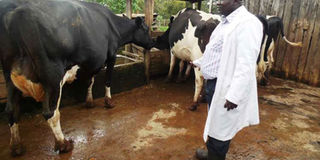Ten-point checklist to make dairy herd productive

A worker at Kabianga High School with their dairy herd in December last year. PHOTO | ANDREW MIBEI | NATION MEDIA GROUP
What you need to know:
- In a normal dairy herd, calving should occur throughout the year. Not less than 80 per cent of mature dairy cows in the herd should be lactating.
- Good reproductive management minimises production losses resulting from infertility, long dry periods, culling, reproductive inefficiency related to delayed age at first calving and treatment costs associated with reproductive problems.
- The indicators portray normal and proper functioning of an animal and are vital in sustaining the reproductive efficiency of your dairy herd.
Commercialisation of dairy farming has led to increased use of intensive systems to rear cows. Such systems pose numerous challenges when it comes to animal management.
One of the challenges is infertility, which is the inability of a cow or heifer to conceive or carry the young one to birth.
For the bull, it refers to the inability of the animal to successfully mount a cow or heifer and make it conceive. Fertility is, therefore, important in the reproductive soundness of animals.
In a normal dairy herd, calving should occur throughout the year. Not less than 80 per cent of mature dairy cows in the herd should be lactating.
Good reproductive management minimises production losses resulting from infertility, long dry periods, culling, reproductive inefficiency related to delayed age at first calving and treatment costs associated with reproductive problems. There are fertility indicators used to measure reproductive soundness.
The indicators portray normal and proper functioning of an animal and are vital in sustaining the reproductive efficiency of your dairy herd.
i) Calving intervals: Ideally, every dairy farmer must strive to have one calf per cow every year. This is achievable only by ensuring that your dairy cow is served (inseminated) within 45 to 90 days after giving birth.
It is not advised to inseminate a cow before the 45 days after birth lapse since the some of the cow’s reproductive organs would not have healed sufficiently from the trauma of birth.
ii) Return to heat: A cow should be able to come on heat 45 days after giving birth. Unfortunately, if it is not fed well, it may fail to show heat signs. Always provide adequate feeds in form of a balanced ration containing the requisite nutrients namely energy, crude protein, minerals, vitamins and water.
iii) Conception rate: A good herd requires the least number of services per cow to conceive. On average, the number of services in a herd should be 1.5 times. This practically means that for every two cows that successfully conceive, one may have been served at most twice while the other just once.
For instance, if you have 10 in-calf cows, then five may have been served twice each while the remaining five, served once each. This brings the total number of services for the herd to 1.5.
iv) Lactation period: To attain the target of at least a calf per cow, per year, then a lactating cow should be milked for about 305 days. After this period, drying off should be carried out on the cow by stopping milking.
If at this point the animal is still producing a lot of milk, dry cow therapy can be applied with the help of an animal health practitioner or vet officer.
v) Dry period: The dry or resting period refers to the time when a cow is no longer being milked between the end of a lactation period and the next birth.
Ideally, cows should be rested for about two months. Adequate resting ensures that the cow is able to build up nutrient reserves for a healthy, fast-growing calf as well as high productivity in the next lactation period.
vi) Oestrus cycle: A cow is usually on heat for about 30 hours every 21 days. The first 10 hours of the heat period marks the pre-heat time followed by about 18 hours of standing heat.
The best time to serve a cow is six hours after the onset of standing heat up until the end of the period. Standing heat is the period when a cow on heat stands without moving when mounted by others.
vii) Age at first oestrus: A heifer should first come on heat at 12 months. The earlier the attainment of puberty, the longer the productive lifetime of a cow and the more the financial returns.
viii) Age at first breeding: Heifers are conventionally first served at 18 months, though this could come earlier if the heifer attains the right body weight beforehand.
The right weight is approximately 60 per cent of the mature body weight. Generally, this is about 230-300kg for small breeds and 300-350kg for large breeds.
ix) Age at first calving: Conventionally, the age should be around 27 months though with proper nutrition, 24 months is attainable.
x) Pregnancy diagnosis: This is the determination of an animal’s pregnancy status to ascertain whether it is carrying a viable foetus. Methods used include observation of non-return to heat, rectal palpation, hormonal assays, observation of physical changes on the animal and ultrasound. Use of rectal palpation, hormonal assays and ultrasound provide more concrete results, but require qualified technicians.




